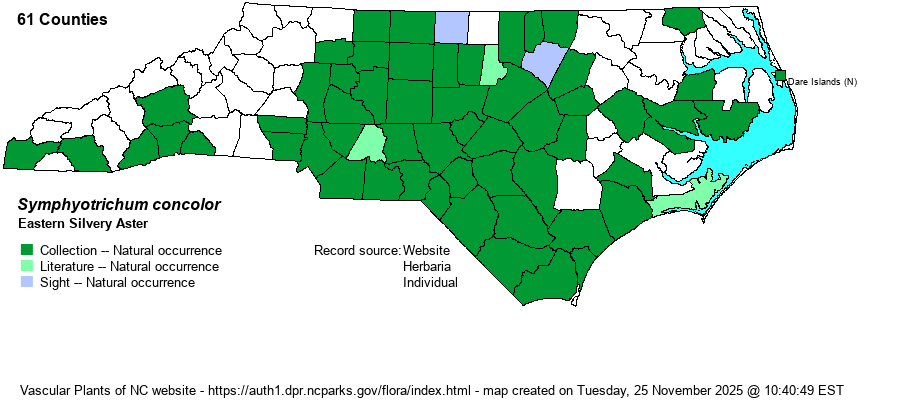| Author | (L.) Nesom | |
| Distribution | Piedmont, Sandhills, and Coastal Plain; also in the southern Mountains at low elevations; rare on the Outer Banks (Colington Island in 1954).
VA and KY south to FL and LA; northward on the Coastal Plain to MD, DE, NJ, NY, RI, and MA. | |
| Abundance | Common in the Sandhills and the southern Coastal Plain; fairly common to locally common in the central and eastern Piedmont. Infrequent in the northern and central Coastal Plain and the southern Mountains. Very rare to absent in the foothills and northern Mountains. | |
| Habitat | Dry to mesic pine-oak-hickory woodlands, Longleaf Pine-Wiregrass loamy savannas and uplands, rocky slopes, roadsides, powerlines, clearings and edges. Favors dry soil in full to partial sun. | |
| Phenology | Flowering and fruiting September-October. | |
| Identification | Eastern Silvery Aster is an elegant, wand-like plant. Stems grow 1-10 or more together, 1-2.5 feet tall, unbranched or with a few strongly ascending branches. The dozens of stem leaves are elliptic, stalkless, toothless, and held erect. Stems and leaves are appressed-hairy with whitish soft hairs, imparting a silvery to grayish tone to the plant. Inflorescences are terminal, spike-like and/or with short branches, with lavender-blue or lavender-purple rays and bright yellow disks. These plants often lean to a diagonal to occasionally horizontal position, easily blowing in slight breezes. | |
| Taxonomic Comments | NOTE: The genus Aster was examined by G.L. Nesom (1994), who determined that it was composed of a number of discrete genera (a few of which were already split off by authors as Sericocarpus, Ionactis, etc.). The earliest available name for North American "Aster" is Symphyotrichum, a name regrettably long and hard to spell.
Our plants are variety concolor.
| |
| Other Common Name(s) | None | |
| State Rank | S5 | |
| Global Rank | G5 | |
| State Status | | |
| US Status | | |
| USACE-agcp | | |
| USACE-emp | | |

